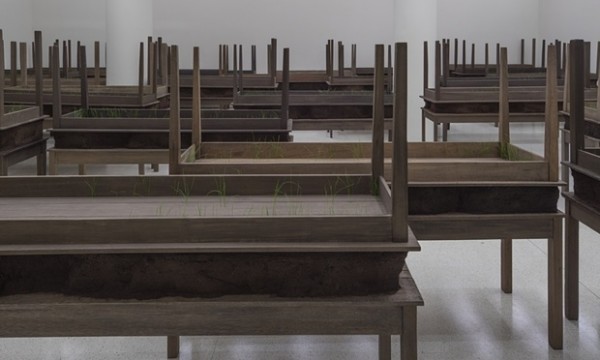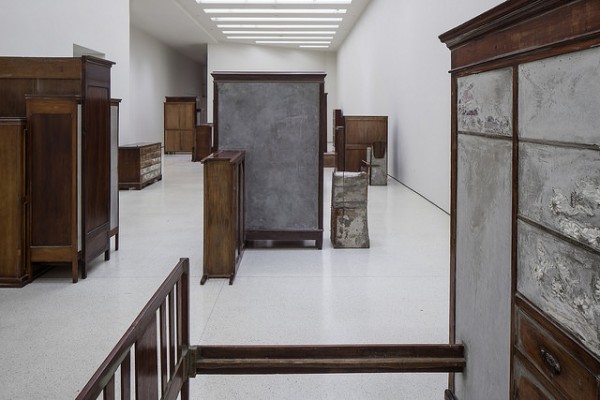
“Plegaria Muda” evokes mass graves in Doris Salcedo exhibition at the Guggenheim (photo by David Heald/Solomon R. Guggenheim Foundation)
Solomon R. Guggenheim Museum
1071 Fifth Ave. at 89th St.
Exhibition: Friday – Wednesday through October 12, $25
Symposium: Friday, October 2, $15, 11:00 am – 6:30 pm
212-423-3587
www.guggenheim.org
Colombian artist Doris Salcedo encapsulated her powerful, emotional oeuvre beautifully and succinctly in a recent interview with Marguerite Feitlowitz: “My work is based on the testimonies of victims of violence, on experiences that are alien to me,” she explained. “I am not a direct witness; I am witness to the witness, a secondary witness. I search for an intimate proximity with the victims of violence that will permit me to stand in for them as I actually make the work, but in such a way that their experience takes precedence over my own.” For three decades, the Bogotá native has been creating installations that examine the social injustice and violence experienced in Colombia and other parts of the world. She uses common domestic objects that each visitor can relate to, building on their evocation of memory and loss. Her current retrospective at the Guggenheim is installed on all four tower levels, allowing museumgoers plenty of time as they go from one section to another to process what they have just seen in one gallery before entering the next. “Plegaria Muda,” roughly translated as “silent prayer,” memorializes both mass gang killings in South Central Los Angeles and murders committed by the Colombian army between 2003 and 2009. The piece is a maze made of pairs of handcrafted tables inverted upon each other, with earth sandwiched between them. Blades of grass rise through the earth, life emerging from dozens of anonymous graves.

“La Casa Viuda” is part of haunting retrospective at the Guggenheim (photo by David Heald/Solomon R. Guggenheim Foundation)
For “Atrabilarios,” Salcedo takes shoes left behind by los desaparecidos (individuals “disappeared” by security forces) and places them in wall niches, covering them with rectangles of semitranslucent animal fiber that is hand-stitched into the wall with medical sutures, the shoes fading away like slowly forgotten memories or barely healed scars. “A Flor de Piel” is a large floor piece composed of stitched-together, chemically treated rose petals, forming a kind of burial shroud for a Colombian nurse who was kidnapped, tortured, and killed. Salcedo uses silk thread and nearly twelve thousand burned needles to make “Disremembered,” a collection of barely there tuniclike hair shirts that combine beauty and pain. “Untitled” brings together hospital cots wrapped in animal fiber with stacks of crisply folded white shirts impaled by steel rebar, associating loss and violence with a place meant for healing. And “La Casa Viuda” is a room containing doors, dressers, tables, chairs, and other furniture connected, filled in, or closed off with concrete, a house devoid of people, no longer fit for human occupancy. Individually, the pieces demand silent contemplation and introspection, but as a whole, the exhibition will also make you angry about what is still happening all over the globe, brutal murders and disappearances that seemingly cannot be stopped. The moving exhibition, which also includes a video screening of Salcedo’s public projects, continues at the Guggenheim through October 12; on October 2, the artist will participate in an all-day symposium along with Elizabeth Adan, Carlos Basualdo, Katherine Brinson, Leslie Jamison, Roderick Mengham, Jean-Luc Nancy, and Alexander Nemerov.